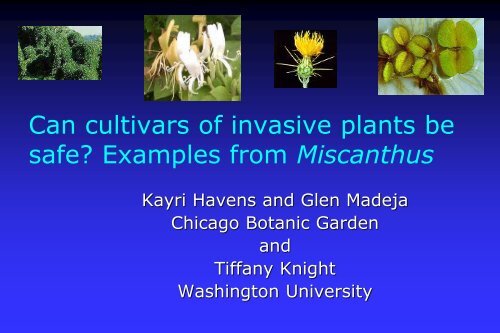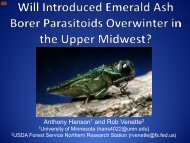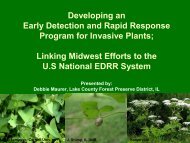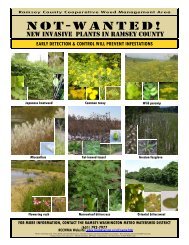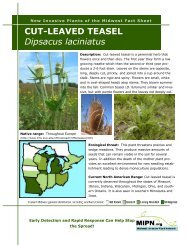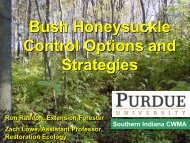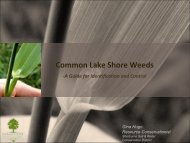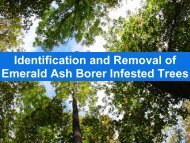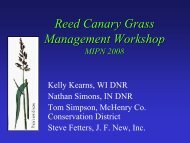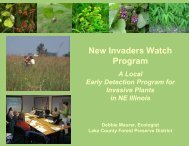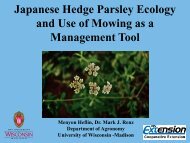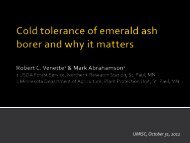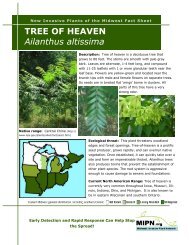Evaluation of Miscanthus Cultivars for Fecundity and Potential ...
Evaluation of Miscanthus Cultivars for Fecundity and Potential ...
Evaluation of Miscanthus Cultivars for Fecundity and Potential ...
Create successful ePaper yourself
Turn your PDF publications into a flip-book with our unique Google optimized e-Paper software.
Can cultivars <strong>of</strong> invasive plants be<br />
safe? Examples from <strong>Miscanthus</strong><br />
Kayri Havens <strong>and</strong> Glen Madeja<br />
Chicago Botanic Garden<br />
<strong>and</strong><br />
Tiffany Knight<br />
Washington University
The Invasive Problem<br />
• Invasive species are the 2 nd<br />
largest threat to biodiversity<br />
• We depend on biodiversity<br />
• Food, Medicines<br />
• Shelter<br />
• Ecosystem services<br />
• Invasive species cost the US<br />
$138 billion/year, invasive<br />
plant costs are conservatively<br />
$35 billion/year
The “Cultivar Issue”<br />
• <strong>Cultivars</strong> can vary<br />
significantly in their<br />
fecundity<br />
• When a wild type <strong>and</strong>/or<br />
one or more cultivars are<br />
invasive, should all be<br />
banned?<br />
• Are “sterile” cultivars<br />
always sterile?
Modeling effect <strong>of</strong> fecundity on<br />
population growth rate<br />
• We took a demographic approach to<br />
ask, “When reducing fecundity <strong>of</strong><br />
cultivars, how much is enough to create<br />
a plant that will not be invasive?”<br />
• Modeling was done by Tiffany Knight<br />
(Washington University)
Japanese Barberry (Berberis thunbergii)<br />
A popular horticultural shrub that has become a natural area invader<br />
“The reasons? Sheer growability… hardy<br />
to zone 4, can take sun or shade, wet or<br />
dry, <strong>and</strong> will come back strong after a<br />
beating.”<br />
“one <strong>of</strong> the most destructive invasive plants in Connecticut”<br />
--Connecticut Botanical Society
Why the resistance?<br />
Japanese Barberry sales in Connecticut Alone<br />
--$15-20 million Annually--
Why the resistance?<br />
35 <strong>Cultivars</strong> <strong>of</strong> Japanese Barberry<br />
• Aurea<br />
• Bonanza Gold<br />
• Angel Wings<br />
• Crimson Giant<br />
• Rosy Glow<br />
Individuals within these range from producing less than<br />
100 to over 3000 seeds per year<br />
“I know that some Barberries have become invasive but<br />
mine doesn't really set any seed <strong>and</strong> my plants are<br />
only 2 feet high after almost 5 years in the ground.”
A demographic approach<br />
Cultivar #1<br />
Cultivar #2<br />
0.05<br />
0.95<br />
0.50<br />
0.95<br />
Seedling<br />
0.05<br />
Juvenile<br />
0.80<br />
Adult<br />
Seedling<br />
0.05<br />
Juvenile<br />
0.35<br />
Adult<br />
1000 * 0.10<br />
50 * 0.10<br />
λ=1.50<br />
λ=1.00
Plant invasions <strong>and</strong> matrix models<br />
Plant<br />
Life <strong>for</strong>m<br />
Invasive Range Selected Reference<br />
Dipsacus sylvestris Biennial USA Werner <strong>and</strong> Caswell 1978<br />
Alliaria petiolata Biennial USA Davis et al. 2006<br />
Carduus nutans Monocarpic herb New Zeal<strong>and</strong> Shea <strong>and</strong> Kelly 1998<br />
Heracleum mantegazzianum Monocarpic herb Europe Nehrbass et al. 2006<br />
Cirsium vulgare Monocarpic herb USA Tenhumberg et al. 2007<br />
Molinia caerulea Perennial grass Western Europe Jacquemyn et al. 2005<br />
Agropyron cristatum Perennial grass USA Hansen <strong>and</strong> Wilson 2006<br />
Lespedeza cuneata Perennial herb USA Schutzenh<strong>of</strong>er <strong>and</strong> Knight 2007<br />
Centaurea maculosa Perennial herb USA Emery <strong>and</strong> Gross 2005<br />
Clidemia hirta Shrub USA DeWalt 2006<br />
Ardisia elliptica Shrub USA Koop <strong>and</strong> Horvitz 2005<br />
Cytisus scoparius Shrub USA Parker 2000<br />
Pinus nigra Tree New Zeal<strong>and</strong> Buckley et al. 2005
Alliaria petiolata (Garlic mustard)<br />
A typical short-lived invasive plant<br />
Seed<br />
Rosette<br />
Adult<br />
Seed<br />
Bank<br />
Rosette<br />
Adults<br />
Davis et al. 2006
Alliaria petiolata (Garlic mustard)<br />
A typical short-lived invasive plant<br />
Seed<br />
Rosette<br />
Adult<br />
0.02<br />
0.27<br />
Seed<br />
Bank<br />
.026<br />
0.36<br />
0.03 0.62<br />
Rosette<br />
0.09 0.45<br />
.27<br />
Adults<br />
λ=1.42<br />
0.09<br />
Davis et al. 2006
Population growth rate (λ)<br />
Reducing seed output reduces population<br />
growth <strong>of</strong> garlic mustard<br />
2.5<br />
2.0<br />
1.5<br />
a<br />
1.0<br />
0.5<br />
a<br />
a<br />
a<br />
a<br />
a<br />
a<br />
a<br />
a<br />
a<br />
a<br />
0<br />
0 20 40 60 80 100<br />
Percent reduction in seed production or viability
Population growth rate (λ)<br />
Short-lived invasive species<br />
2.5<br />
d<br />
e d<br />
e<br />
2.0<br />
ca<br />
ca<br />
1.5 ci p<br />
s<br />
a<br />
ci p<br />
a s<br />
d<br />
e<br />
ca<br />
ci p<br />
a<br />
s<br />
1.0<br />
0.5<br />
d<br />
d<br />
d<br />
e<br />
d<br />
e<br />
d<br />
ca e<br />
ci<br />
d<br />
p ca<br />
a<br />
ci e<br />
a<br />
p ca ci<br />
p<br />
d<br />
a ci e<br />
ca p<br />
a ci e<br />
ca a<br />
p<br />
ci<br />
s<br />
p<br />
ca<br />
a<br />
e<br />
ci p<br />
a<br />
s<br />
ca<br />
s<br />
a d<br />
ci<br />
s<br />
0<br />
s s s ca<br />
0 20 40 60 80 100<br />
Percent reduction in seed production or viability<br />
e p<br />
Species<br />
a Alliaria petiolata<br />
ca Carduus nutans<br />
ci Cirsium vulgare<br />
d Dipsacus sylvestris<br />
e Echium plantagineum<br />
p Polygonum perfoliatum<br />
s Setaria faberi
So, reduced seed output is likely to reduce<br />
population growth <strong>of</strong> short-lived species….<br />
…..But, what about long-lived species such<br />
as shrubs <strong>and</strong> trees?
Scotch Broom (Cytisus scoparius)
Cytisus scoparius (Scotch Broom)<br />
422<br />
97.5<br />
0.32<br />
0.03<br />
0.37<br />
0.60<br />
0.23 0.02 0.21<br />
0.01 0.35<br />
0.01<br />
0.39<br />
0.05<br />
0.46<br />
0.37<br />
0.11<br />
0.01<br />
0.03<br />
0.03<br />
0.49<br />
861<br />
0.01<br />
2725<br />
0.44<br />
0.11<br />
0.85<br />
λ=1.40<br />
Parker 2000
Population growth rate (λ)<br />
Reducing seed output has minor<br />
effects on scotch broom<br />
2.5<br />
2.0<br />
1.5<br />
cy cy cy cy cy cy cy cy cy<br />
1.0<br />
cy<br />
cy<br />
0.5<br />
0<br />
0 20 40 60 80 100<br />
Percent reduction in seed production or viability
Population growth rate (λ)<br />
Long-lived invasive species<br />
2.5<br />
2.0 p<br />
m<br />
p p<br />
m p<br />
m p<br />
cl cl m<br />
p<br />
cl m<br />
p<br />
cl m<br />
p<br />
cl m<br />
p<br />
cl<br />
1.5<br />
cl m p<br />
cy cl m<br />
ce cy<br />
ce<br />
cy cy<br />
ce<br />
cy cl m<br />
ce<br />
cy cy<br />
a a a a<br />
ce cy cl<br />
r r r r a r ce<br />
cy<br />
a r ce a r<br />
ce<br />
a r a r cy r<br />
a<br />
r<br />
1.0<br />
ce m a cl p<br />
ce cy<br />
ce<br />
Species<br />
a Ardesia elliptica<br />
ce Centaurea maculosa<br />
cl Clidemia hirta<br />
cy Cytisus scoparius<br />
m Molina caerulea<br />
p Pinus nigra<br />
r Rubus discolor<br />
0.5<br />
0<br />
0 20 40 60 80 100<br />
Percent reduction in seed production or viability
Population growth rate (λ)<br />
Population growth rate (λ)<br />
Reducing seed output has larger effects on the<br />
growth rate <strong>of</strong> short-lived species<br />
2.5<br />
2.0<br />
1.5<br />
1.0<br />
0.5<br />
0<br />
Short-lived species<br />
d e d<br />
e d<br />
d<br />
e d<br />
ca e<br />
d<br />
ca d<br />
ci p ca e<br />
s<br />
d<br />
a ci p ca e<br />
a s ci p<br />
a ci<br />
d<br />
ca<br />
a<br />
p ci e<br />
a p ca ci<br />
s<br />
p a e d<br />
ca p<br />
ci<br />
a ci e<br />
ca a<br />
p ci<br />
s<br />
p<br />
ca a<br />
e<br />
ci p<br />
a<br />
e p<br />
s<br />
ca<br />
s<br />
a d<br />
ci<br />
s<br />
s s s ca<br />
0 20 40 60 80 100<br />
2.5<br />
Long-lived species<br />
2.0 p<br />
m p<br />
m<br />
p p<br />
cl m p<br />
cl m<br />
p<br />
cl m p<br />
cl m<br />
p<br />
cl cl m p<br />
1.5<br />
cl m p<br />
m<br />
ce<br />
cy<br />
ce<br />
cy cy<br />
cl<br />
ce<br />
cy cy cl m<br />
a ce r a r cy<br />
a r a r cy ce cy cl<br />
a r ce a r ce a r cy<br />
ce<br />
a r a r a<br />
cy<br />
1.0<br />
r ce m<br />
r<br />
a cl p<br />
ce cy<br />
ce<br />
0.5<br />
0<br />
0 20 40 60 80 100<br />
Percent reduction in seed production or viability
Conclusions from models<br />
Reductions in seed output will not necessarily<br />
result in non-invasive cultivars, particular <strong>for</strong><br />
long-lived species<br />
Demographic modeling can illuminate the<br />
invasive potential <strong>of</strong> different cultivars if you<br />
have the data<br />
-seed output, seed viability<br />
-life history (time to reproduction)<br />
Knight, Havens <strong>and</strong> Vitt, 2011, BioScience 61: 816-822
<strong>Evaluation</strong> <strong>of</strong> <strong>Miscanthus</strong> sinensis<br />
cultivars<br />
• A long lived perennial grass that <strong>for</strong>ms large<br />
clumps (doesn’t run like M. sacchariflorus)<br />
• Known to invade in eastern U.S.<br />
• <strong>Fecundity</strong> will need to be zero (or extremely<br />
close to zero) in order <strong>for</strong> the cultivar to be<br />
unlikely to invade<br />
• Glen Madeja (NU grad student) evaluated 35<br />
cultivars <strong>for</strong> fecundity in the Chicago region<br />
(Madeja et al., 2012, J Env Hort, in press)
<strong>Miscanthus</strong> trials<br />
Glen taking data ><br />
Tiffany with ‘Morning Light’ >
Quantifying seed set<br />
• R<strong>and</strong>omly harvested 3<br />
infloresences per individual<br />
• X-rayed inflorescences<br />
• 2 people independently<br />
counted filled seeds <strong>and</strong><br />
averaged<br />
• Multiplied by number <strong>of</strong><br />
inflorescences on individual<br />
• Averaged filled seed set over<br />
4 individuals per cultivar
Cultivar<br />
Average Filled<br />
Seed Set<br />
Cultivar<br />
Average Filled<br />
Seed Set<br />
Kleine Silberspinne 191,202 Ferner Osten 9,190<br />
Rotsilber 179,957 Goliath 7,137<br />
Autumn Light 157,936 Sarab<strong>and</strong>e 3,278<br />
Malepartus 106,172 Gracillimus 3,146<br />
Blutenwunder 91,569 Little Zebra 1,359<br />
Graziella 90,984 Superstripe 1,226<br />
Nippon 81,024 Gold Bar 1,031<br />
Huron Sunrise 77,925 Morning Light 968<br />
Minuett 69,997 Strictus 907<br />
Andante 61,103 Dixiel<strong>and</strong> 785<br />
Silberfeder 49,060 M. sacchariflorus 746, but runs!<br />
Adagio 27,078 Variegatus 211<br />
Puenktchen 19,376 Yaku-jima 138<br />
Silberturm 19,133 Hinjo 0<br />
Zebrinus 16,621 Silberpfeil 0<br />
Purpurascens 13,390 M. x giganteus 0<br />
Autumn Red 12,995 Cabaret 0, but died out
Conclusions<br />
• Three ornamental cultivars (‘Silberpfiel’, ‘Hinjo’ <strong>and</strong><br />
‘Cabaret’) <strong>of</strong> <strong>Miscanthus</strong> sinensis <strong>and</strong> the hybrid<br />
<strong>Miscanthus</strong> x. giganteus (used ornamentally <strong>and</strong> as a<br />
potential bi<strong>of</strong>uel crop) have not set seed in Chicago <strong>and</strong><br />
thus appear to have a low invasion risk.<br />
• ‘Cabaret’ was not reliably hardy, so was not<br />
recommended.<br />
• These results should be interpreted with caution because<br />
it is possible they may be able to set seed as the plants<br />
mature <strong>and</strong>/or as the climate warms. These cultivars<br />
may be able to mature seed in warmer regions <strong>of</strong> the<br />
US. One <strong>of</strong> our seedless cultivars (‘Hinjo’) did set seed<br />
in Zone 5 in another trial.
Acknowledgements:<br />
• Thanks to the staff <strong>of</strong> the<br />
Division <strong>of</strong> Plant Science<br />
<strong>and</strong> Conservation <strong>and</strong><br />
collaborators on these<br />
projects who shared data<br />
<strong>and</strong> photos <strong>for</strong> this talk:<br />
Pati Vitt, Glen Madeja,<br />
Tiffany Knight, Lauren<br />
Umek.


